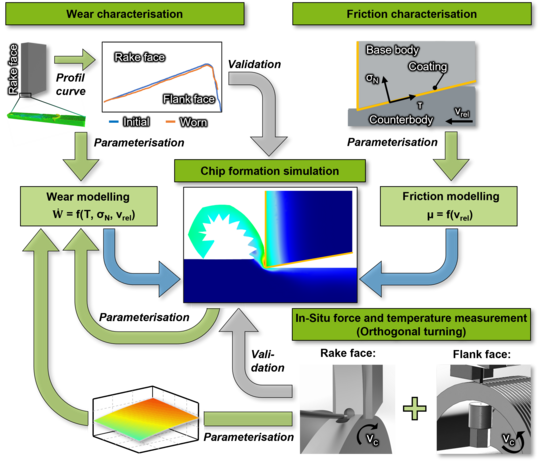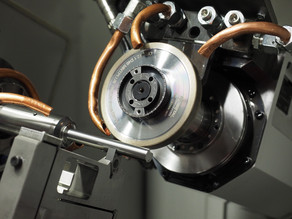Characterisation and Modelling of the Wear Behaviour of Coated Cemented Carbide Tools Used for Turning a Hard to Machine Steel
Due to the advancing climate change and the resulting limitation of global CO2 emissions, a reliable, productive and above all resource-saving machining of industrial products is required. In this context, the wear of cutting tools is of central importance as it influences both process reliability and productivity. The term wear covers a complex collective of mechanisms that cause geometric and material changes in the tool in various appearances. These mechanisms are subject to different dependencies, such as the tool-material pairing or the thermomechanical load collective in the chip formation zone, which is significantly influenced by the cutting values. In order to efficiently optimize and further develop tools and processes, detailed knowledge of these dependencies is very crucial. Especially for the use of simulation systems, which nowadays can realize a time and resource saving process and tool development, experimentally determined results are necessary both as input data for the simulation and for validation.
Within the scope of this project, a modelling of the wear of coated carbide tools during machining of the austenitic steel X2CrNiMo17-12-2 based on modern characterization methods will therefore be developed and implemented in a finite element simulation. For this purpose, cutting tests with a titanium nitride and a titanium boron nitride coating will be carried out on a CNC turning machine, using innovative measuring methods to measure the temperatures on the rake and flank face as well as the tool wear. Subsequently, experiments to characterize the frictional behaviour between the material and the coatings will be carried out, by measuring the frictional stress and the normal stress, under similar machining conditions and variation of the relative velocity. The results of these investigations are used in combination with experimentally determined flow stress data to develop a finite element model of chip formation. From this model, which is validated using the mechanical and thermal tool loads from the machining tests, the relative velocities and pressures in the contact area between tool and workpiece or tool and chip can be predicted. By combining these data with the results of the experimentally performed temperature and wear measurements, models of the wear rate depending on the coating as well as the temperature, relative velocity and pressure are subsequently calculated. Finally, these models are implemented in the existing simulation so that the wear during turning can be predicted.





![[Translate to English:] [Translate to English:]](/storages/isf-mb/_processed_/a/1/csm_Wendel_Tiefbohrer_51a08eea1c.jpg)